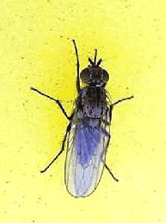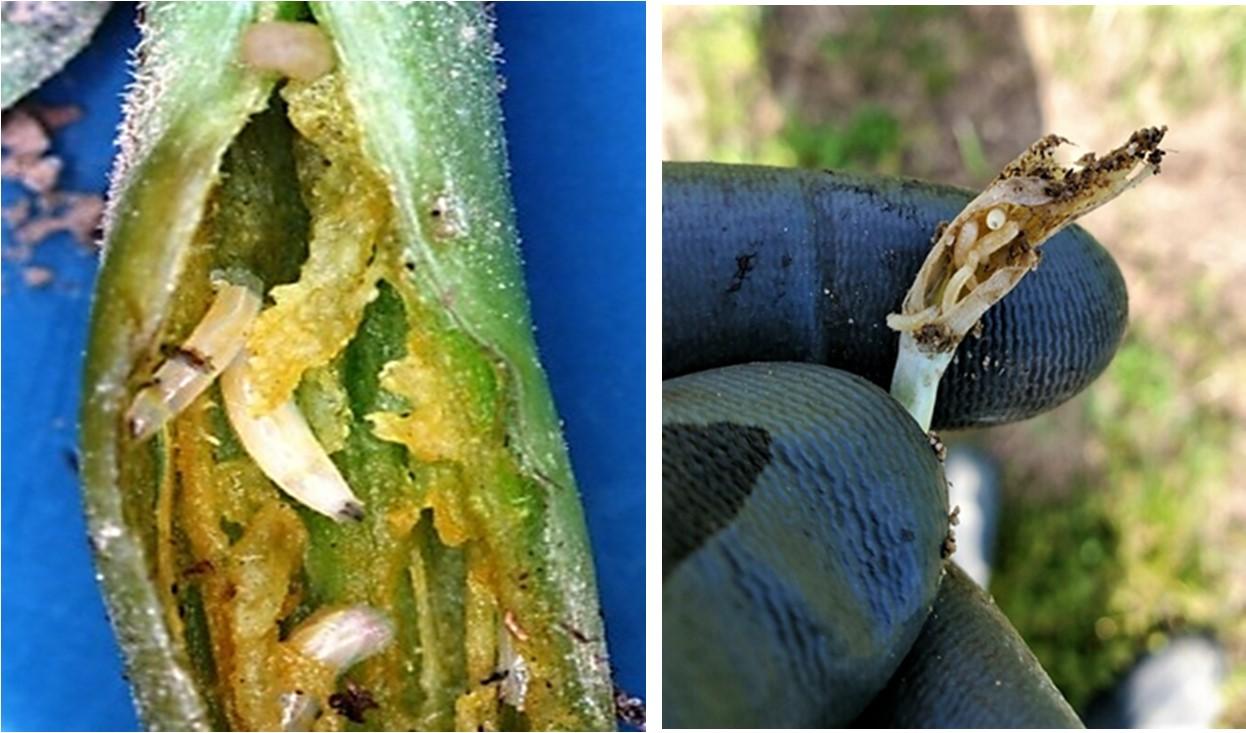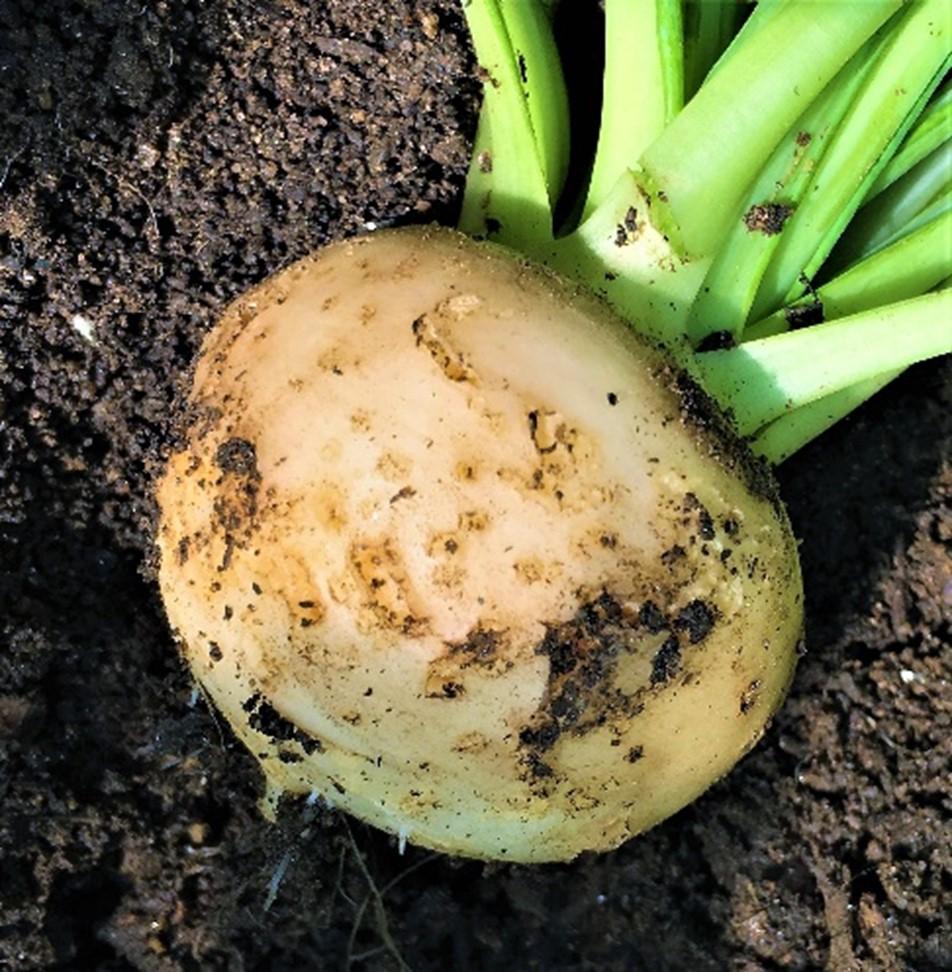Seed Maggots Very Active in Early Planted Vegetables
The warmer than usual February and the cooler weather we have been having the last 3-4 weeks has created ideal conditions for one of our more problematic early season pests, namely seed maggots. These maggots include seedcorn maggot Delia platura (SCM), onion maggot Delia antiqua (OM) and cabbage maggot Delia radicum (CM). All three species overwinter in the soil as a maggot inside a brown pupal case (fig. 1). In March and April small, grayish-brown flies (fig. 2) emerge, which are usually SCM or possibly CM, OM flies usually peak 3-4 weeks later. Adult flies are most active from 10 a.m. – 2 p.m. and are inactive at night, in strong winds or when temperatures are below 50o F or above 80o F. Adults live 2-4 weeks and females lay hundreds of eggs.



Seedcorn maggot eggs are oviposited in soils with decaying plant material or manure. Onion maggot females lay eggs in soil near onion plants. Female cabbage maggot flies seek out and lay eggs on the lower portions of stems of young host seedlings or in nearby cracks in the soil. Some wild crucifers, such as yellow rocket, are important hosts for cabbage maggot and are especially important for their overwintering success; when these weeds are abundant they can lead to heavy infestations of spring crucifers.

Seedcorn maggot adults also are attracted to the organic media around the roots of transplants where they lay their eggs. Within a few days the eggs hatch and the tiny maggots burrow into roots or stems and damage is usually restricted to the early seedling stage of vegetables. SCM larvae will move into small stems and move up the plant causing a swelling of the stem just above ground level, while also causing root collapse and decay. If these stems are split you usually can find the white cylindrical larvae (fig. 3). Onion or cabbage maggots inflict similar damage but usually continue to feed on the expanding bulb during later stages of growth (fig. 4). A single maggot can destroy up to 20 small seedlings. Both SCM and OM can attack onion bulbs, but SCM also can attack vegetable seeds and transplants.
Complete larval development requires 2-4 weeks. Maggots then enter a pupal stage that lasts another 2-4 weeks. There are 3-4 generations per season in our area, with the most destructive being the early spring and later fall generations. When wilted transplants or newly emerging seedlings are inspected in the field, maggots are sometimes not found (they have already pupated), but their tell-tale damage appears as hollowed out seeds or stems and roots held together by a few strands of plant material.
Cultural Controls: Avoid planting in soils that have a great deal of non-decomposed organic matter, such as fields with manure or compost applications or a heavy cover crop or are very weedy. Rotate early season crops away from any areas that had onions or crucifers last fall. Early spring-planted crops are more likely to be damaged when the soil is too cold for rapid germination and emergence. If serious infestations are expected, wait until the soil warms up in the spring. Recently seeded or transplanted crops can be covered with floating row covers, which act as barriers against any of the root maggot flies. Do not use row covers where onions or brassicas were grown the previous year. When soil temperatures increase and maggot first-flights end, the row covers can be removed.
Chemical Management: Treatments should be applied pre-plant or at-planting to be effective. The use of treated seed (Commercially treated seed only: for onion- Trigard ST or Cruiser 5FS for peas and beans) or soil application of an insecticide give good to moderate control of SCM, CM and OM. There are several ways to apply an insecticide to the soil at or right after planting: 1. Through low pressure drip or trickle irrigation, 2. An in furrow spray directed on or below the seed, 3. A narrow (< 2 inches) surface band spray over the seed line during planting that is incorporated to a depth of 1 - 1½ inches with sufficient irrigation within 24 hours of application, 4. A post seeding drench, transplant water drench, or hill drench. Unfortunately, there are not many chemicals that can be used for control, however some of the chemicals that can be used include: 1. Diazinon AG500 (onions-moderate control; for Cole crops not labeled for cabbage maggot on collards, kale and kohlrabi) 2. Cyantraniliprole (Verimark, Cole crops) 3. Tolfenpyrad- soil applied (Torac, Cole crops) 4. Imidacloprid has been found by growers to reduce maggot damage when it is soil applied and is registered for use for other pests on the crop. 5. The post-planting sprays of malathion or pyrethroids are meant to control or reduce the adult fly populations but are not that effective and will do little to control maggots already present in the soil. The use of these products can vary depending on the particular crop so be sure to check the label before using.
This article appears in April 2023, Volume 14, Issue 2 of the Vegetable and Fruit News.
Vegetable & Fruit News, April 2023, Volume 14, Issue 2
Vegetable and Fruit News is a statewide publication for the commercial vegetable and fruit industries and is published monthly during the growing season (April through October). Subscribers will receive an email with the latest edition.
Subscribe